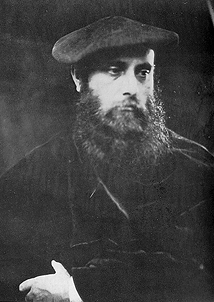Critics fought the battles of realism versus the neoclassical ideal and genre versus heroic art over and over, because their conceptions of painting were so closely related to their political beliefs, and, more important, to their political fears, particularly to their fear of democratic revolutions. Those on the other side were equally insistent that it was all for the good that The Times triumphed.

William Michael Rossetti
William Michael Rossetti, left-wing in both political and religious beliefs, thus argued against allegorical art, because "the tendencies of the age are — we will not say material, but eminently positive," and practical men in the age of Victoria dislike older symbolism and iconography which does not speak to them: "The motto of the practical man, 'Facts and Figures,' may be made to serve his turn as well for pictures as for blue-books; but he is as far from understanding the 'figures' to mean a figurative rendering in the one as figures of speech in the other" ("The Externals of Sacred Art," Crayon, 5 (1858), 334.) It is no coincidence that Rossetti should have chosen as his representative man the reader of parliamentary blue-books, the weapons of the Benthamite political reformer, while Atkinson should have attacked that reformer's credo of the greatest happiness for the greatest number.
One can thus perceive the urgency and the undercurrents in these critical battles, for both Ruskin and the periodical reviewers saw themselves fighting for the allegiance of the new audience for art. Samuel [128/129] Carter Hall's Art-Journal, which Helene Roberts has called "the very voice of the Victorian art establishment," nailed its colors to the mast early in the battle, proclaiming in 1845. "Conservative by education, habit, and principle, we shrink from" the idea of aiding the adversaries of any established institution" (7: 68). Apparently, to weaken the Royal Academy was to weaken the power of conservatism, and to weaken the power of conservatism was to bring on the revolution. Such political elements in Victorian art politics do much to explain why Ruskin and the Pre-Raphaelites were attacked with such vigor: they threatened not only vested interests in the art world but also Order itself. Atkinson thus appropriately repeated attacks made a half century earlier upon the Lake poets, who were also thought politically and socially dangerous, when he lambasted Pre-Raphaelitism as mere "Cockney caprice" (Blackwood's, 94 [1863]: 71). Similarly, as this defender of the old order made clear in an essay entitled "London Exhibitions — Conflict of the Schools," he hated and feared Ruskin as one who had created "civil war of opposing parties [who] threaten the empire of Art with hopeless anarchy." (86 [1859]: 128.).
One can surmise that many conservative critics, such as Eagles and Atkinson, found the claims of Ruskin and the rising school of young painters particularly upsetting, since they themselves had led a sort of revolution in taste. For example, John Eagles, the friend of W. J. Muller and Francis Danby, had been progressive when he espoused the cause of poetic landscape, thus doing his part to attack the practical — if not the theoretical — primacy of history painting. Considered from a sociological point of view, Eagles's writings, particularly the essays published as The Sketcher, stated the claims of the cultured upper-middle-class gentleman to a learned, relatively informal art appropriate to his taste and position in life. The battle — for the conservatives tended to see the history of art in terms of conflict — had just been won when they found [129/130] themselves under attack, not from above but from below. However much they may have urged others that the older order changes, giving place to the new, when an order new to them appeared, they loudly proclaimed that it wasn't time.
18 October 2024
